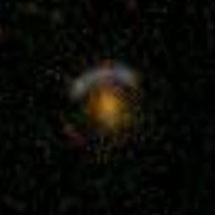

Tuesday - May 18, 2010
SLAC Today is
available online at:
http://today.slac.stanford.edu
In this issue:
Looking at the Galaxy Zoo with (Gravitational) Lenses
Bike to Work Day 2010
 |
 |
|
Tuesday - May 18, 2010 |
Looking at the Galaxy Zoo with (Gravitational) Lenses An example gravitational lens from the SDSS data set. This image is known as the 8 o'clock arc.
Can you tell a gravitational lens from a distant spiral galaxy? With an expansion of the Galaxy Zoo citizen science project, you can try your eye at lens identification, thanks in part to the efforts of Phil Marshall at SLAC and Stanford's Kavli Institute for Particle Astrophyics and Cosmology. Galaxy Zoo, which has been running for three years, is now turning to the Hubble Space Telescope for data, coinciding with HST's 20th anniversary. The original Galaxy Zoo project allowed people to comb through mountains of image data from the Sloan Digital Sky Survey, a ground-based telescope system in New Mexico. The "Zooites," as these 21st century amateur astronomers are known, are able to classify galaxies accurately and efficiently, thus taking part in a massive scientific project and unloading a lot of work from professional astrophysicists. From the very beginning, the Zooites started spotting new and unusual objects—including gravitational lens candidates—on a discussion forum thread started by the Zoo's instigator, Kevin Schawinski. The Web site leads visitors through a questionnaire that helps them learn to properly identify galaxy types, such as elliptical or spiral. Marshall, who studies strong gravitational lenses, and Chris Lintott, Galaxy Zoo principal investigator, realized they could help the Zooites spot lenses more efficiently by adding an additional question to the procedure. This resulted in users identifying several thousand Galaxy Zoo galaxies that show potential lensing-like features. From this large list, Aprajita Verma, who is leading the follow-up investigation from Oxford, selected 20-30 good gravitational lens candidates for further observation. "We know that lenses are very rare," Marshall says. Now, Galaxy Zoo is providing a number of tools to allow the zooites to whittle down their list of lens candidates themselves. "We hope that 'crowd-sourcing' this problem will provide a more complete sample of gravitational lenses than could be generated blindly by computer." With the addition of the Hubble data, scientists have a plethora of new galaxies to sort – galaxies that are much younger and further away because of Hubble's increased scope. Considering there are nearly 250,000 users of Galaxy Zoo, they have plenty of help! For more on gravitational lensing, see the video with Phil Marshall on Symmetry Breaking... Bike to Work Day 2010Last Thursday, 55 cyclists signed in at the SLAC Energizer Station for the Bay Area's 16th Annual Bike to Work Day. Volunteers Judy Fulton, Dwight Harbaugh, Kirk Stoddard and Mike Woods handed out bike bags containing an energy bar, coupons and bicycling literature, supplied by the Silicon Valley Bicycle Coalition and their sponsors. Cyclists also enjoyed coffee cake courtesy of Hobee's Restaurant. SLAC was one of nine Energizer Stations hosted by Stanford this year, and one of more than 80 stations in San Mateo and Santa Clara counties. SLAC cyclists are encouraged to check out Stanford's biking information and resources Web page and to take the Stanford Bike Safet Pledge, which also lets them enter a raffle with a chance to win a bike and other bicycle accessories. |
Events
Access (see all)
Announcements
|
|
| | ||
|
|
||
 <%
Response.AddHeader "Last-modified", getArticleDate()
'Response.AddHeader "Last-modified","Mon, 01 Sep 1997 01:03:33 GMT"
'Monday, December 06, 2010
%>
<%
Response.AddHeader "Last-modified", getArticleDate()
'Response.AddHeader "Last-modified","Mon, 01 Sep 1997 01:03:33 GMT"
'Monday, December 06, 2010
%>View online at http://today.slac.stanford.edu/. |
||